DevOps is transforming how quality assurance (QA) operates in modern software development. Traditionally, QA was siloed, with testing conducted after development. However, DevOps breaks down these barriers by integrating QA into every stage of the software development lifecycle (SDLC). This shift ensures continuous feedback, faster releases, and smarter, data-driven quality decisions. For DevOps engineers, QA isn't just a final step it’s embedded from start to finish.
✨Keep Reading to Explore
📌 Discover how QA is woven into every phase of the SDLC rather than tacked on at the end.
📌 How shift‑left testing and CI/CD pipelines identify defects early and accelerate release cycles.
📌 Role of automated unit, integration, and end‑to‑end tests in ensuring continuous validation.
📌 Understand the importance of Dev-QA collaboration and real‑time monitoring for maintaining production quality.
📌 Explore why ongoing upskilling in DevOps tools and certifications is essential for future‑ready QA teams.
Enterprise teams adopting DevOps benefit from enhanced collaboration, improved testing automation, and robust monitoring. With tools like Azure DevOps, Jenkins, and GitHub Actions, quality is continuously evaluated through pipelines. The fusion of QA and DevOps practices helps reduce bottlenecks, detect bugs early, and ensure stable deployments.
This integration demands that QA teams learn new DevOps tools and methodologies. From understanding the DevOps roadmap to earning DevOps certifications, QA professionals are evolving into technical experts who automate tests, monitor performance, and drive CI/CD strategies.

QA in DevOps: Why It Matters for Modern B2B Engineering Teams
For B2B engineering teams, quality assurance (QA) is not a checkbox, it's a strategic advantage. As businesses push for faster, scalable, and secure software solutions, DevOps ensures that QA is not a bottleneck but a catalyst for innovation.
Key Ways DevOps Enhances QA for B2B Teams:
- Shift from Reactive to Proactive QA
Traditional models placed QA at the end of the cycle. In DevOps, QA is integrated into every stage of the SDLC (Software Development Lifecycle), enabling early detection of issues and faster resolution. - Continuous Integration & Testing
DevOps engineers and QA professionals collaborate using CI/CD pipelines via platforms like Azure DevOps and AWS DevOps, running automated tests with every code change to ensure stability and speed. - Faster Time-to-Market
Early bug detection and automated regression testing minimize delays and reduce costly rework, giving businesses a competitive edge. - Enhanced QA Visibility
With tools like real-time dashboards, alerts, and feedback loops, QA teams get better insights into software performance and defect trends-improving decision-making. - Ongoing Product Maintenance
Modern B2B products require frequent updates, security patches, and feature rollouts. DevOps ensures that QA supports continuous delivery without sacrificing quality.

Upskilling QA for DevOps Success: Roadmap, Certifications, and Tools
- Understanding the DevOps roadmap and earning relevant DevOps certifications (e.g., Azure DevOps certification, AWS DevOps certification) is critical.
- Learning tools like Azure DevOps Boards, Pipelines, and Test Plans helps QA engineers align with DevOps goals.
- Training programs and tutorials help QA professionals evolve into DevOps-aligned contributors.
With DevOps, QA becomes a strategic enabler helping engineering teams build reliable, scalable, and customer-focused B2B software faster than ever before..
DevOps Simplified: What QA Teams Need to Know
For QA teams, DevOps begins with embracing continuous collaboration across development, operations, and QA. It's a cultural shift focused on automation, agility, and monitoring-requiring QA to move beyond manual testing to include automation, CI, and test-driven development.
To simplify DevOps, think of it as a lifecycle: plan, develop, test, release, monitor, and repeat. Each phase is supported by tools like Azure DevOps, Jenkins, Selenium, and Kubernetes. QA teams are responsible for embedding test cases into CI/CD pipelines, ensuring each code change is validated in real-time.
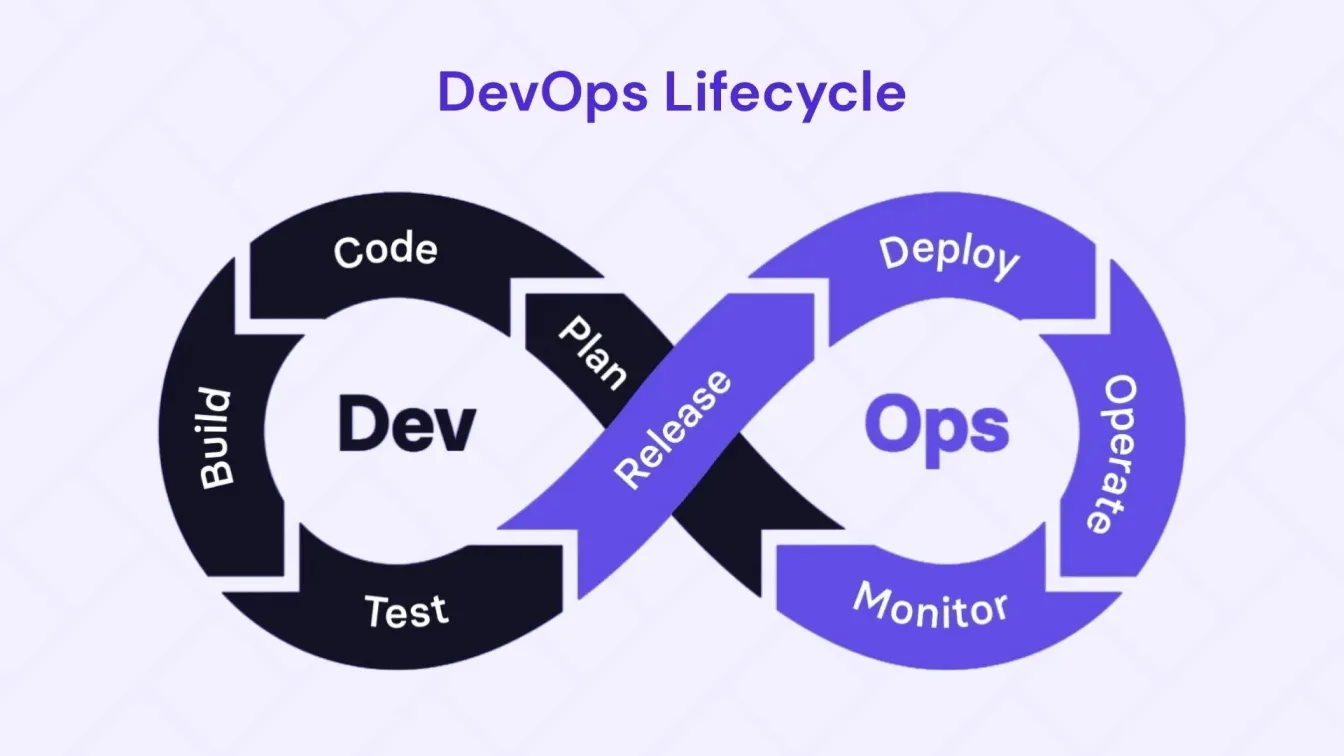
From Legacy to Lean: How QA Has Evolved with DevOps
QA has evolved from reactive, manual testing in legacy models to a proactive role in lean DevOps workflows. Instead of late-stage testing, QA now ensures continuous quality throughout development, reducing delays and costly fixes.
DevOps engineers and QA testers collaborate across CI/CD stages, using tools like Azure and AWS DevOps to automate, monitor, and accelerate delivery without sacrificing quality.
In DevOps, QA must shift from manual testing to automation with tools like Selenium, JUnit, and TestNG. Mastering the DevOps roadmap and earning certifications boosts skills and collaboration.
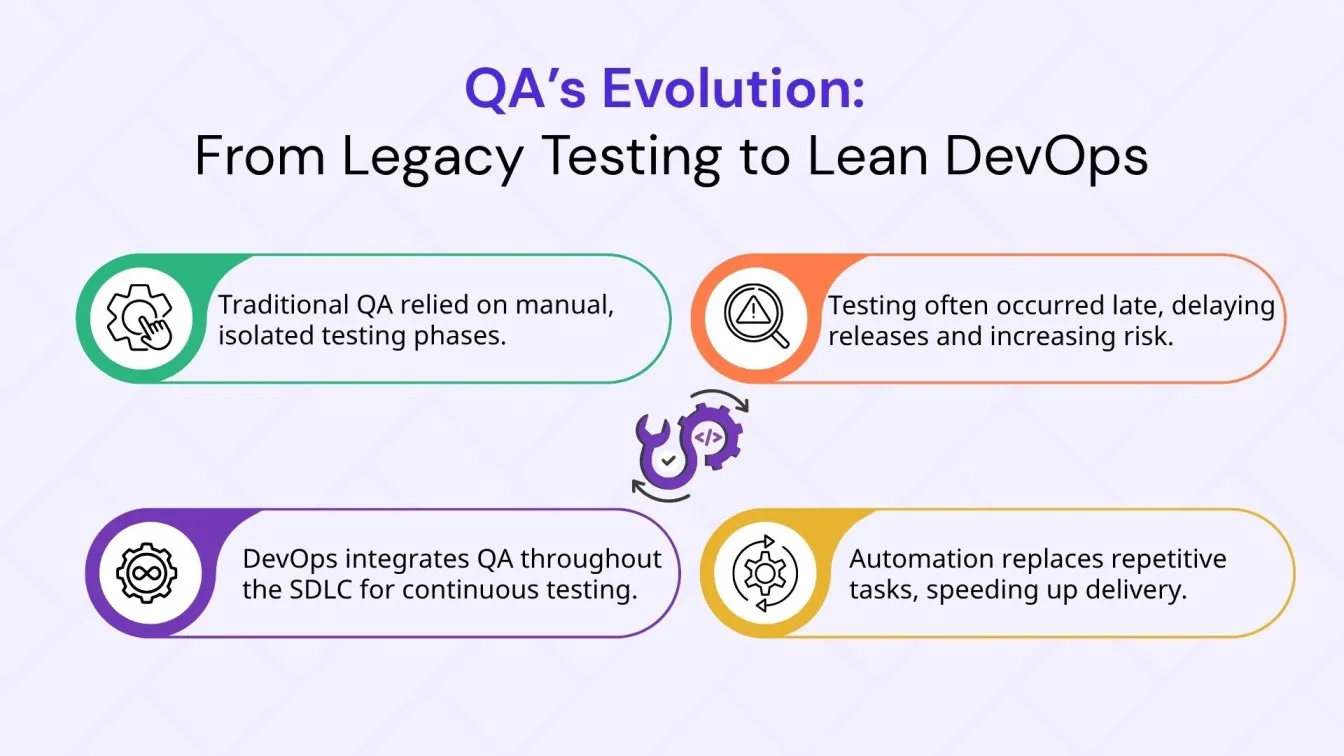
Lean QA in DevOps emphasizes speed, efficiency, and adaptability. It's about catching bugs early, shortening release cycles, and delivering customer value consistently. For businesses, this means lower costs, better performance, and higher customer satisfaction. QA is no longer an afterthought it’s an integral part of DevOps engineering.
How Continuous Integration (CI) Impacts QA
Continuous Integration (CI) is key to DevOps, shaping QA by running automated builds and tests with every code commit. It catches bugs early, reducing risks, saving time, and streamlining development.
For QA teams, CI means testing starts as soon as code is written. Tools like JUnit, TestNG, and Selenium run with every commit, boosting coverage, speeding feedback, and supporting agile development.
DevOps engineers use tools like Azure DevOps, Jenkins, and GitLab to embed QA into CI pipelines, offering reports and logs for quick issue resolution. Learning to configure them is key in many DevOps courses and certifications.

CI also fosters a culture of accountability and shared responsibility. QA is no longer a gatekeeper-it’s a contributor to continuous delivery. With CI, DevOps transforms QA from a phase to a practice, ensuring that quality is built into every step of software development, not just evaluated at the end.
The Role of Continuous Testing in DevOps Pipelines
Continuous testing in DevOps pipelines ensures that software is always in a releasable state. It involves running automated tests throughout the development cycle from code commit to deployment. Unlike traditional QA methods, which test after development, continuous testing provides real-time insights, ensuring that bugs are caught early and quality is maintained at scale.
DevOps engineers embed tools like Selenium, JUnit, and Postman into CI/CD pipelines using platforms like Azure or AWS DevOps. Each change undergoes automated unit, integration, performance, and security tests.

This practice eliminates the delays associated with manual testing, speeds up release cycles, and enables faster feedback loops. It also aligns with the DevOps philosophy of shift-left testing, where testing starts earlier in the software development lifecycle. For QA professionals, mastering continuous testing tools and frameworks is essential to succeed in modern DevOps teams.
Continuous Testing in DevOps: Ensuring Quality at Every Stage
Continuous testing is a core DevOps practice that guarantees software remains in a releasable state throughout the development lifecycle. Unlike traditional QA models that delay testing until after development, continuous testing integrates automated validation from code commit to deployment, providing real-time feedback and reducing time-to-market.
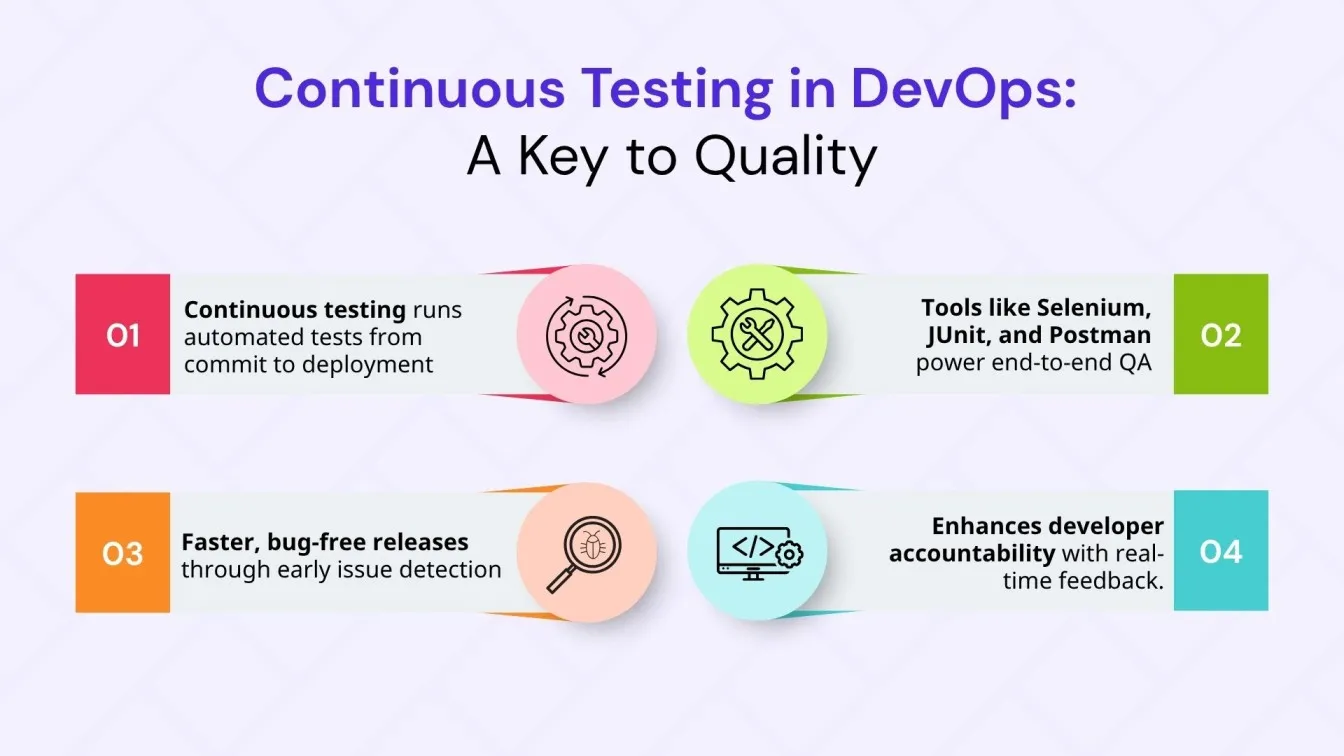
Key Features of Continuous Testing in DevOps Pipelines:
- Real-Time Quality Assurance
Every change whether a new feature or bug fix is validated through a set of automated tests, ensuring that bugs are identified and resolved early. - Automated Test Coverage
Test automation tools such as Selenium (for UI testing), JUnit (for unit testing), and Postman (for API testing) are embedded into CI/CD workflows using platforms like Azure DevOps and AWS DevOps. - Comprehensive Testing Types
Includes unit tests, integration tests, performance benchmarks, and security scans, all executed continuously throughout the pipeline. - Reduced Manual Bottlenecks
Automated testing eliminates the delays associated with manual QA processes and supports faster iteration and delivery. - Alignment with Shift-Left Testing
Continuous testing reinforces shift-left principles, encouraging early and frequent testing to improve software quality and developer accountability.
Why Continuous Testing Matters for QA and DevOps Teams
- It minimizes risk, reduces bugs in production, and ensures smoother deployments.
- QA professionals are expected to master automation tools, CI pipelines, and testing frameworks.
- These skills are often covered in DevOps certifications, tutorials, and real-world DevOps projects.
By embedding QA into every stage of the pipeline, continuous testing becomes the backbone of reliable DevOps delivery driving efficiency, stability, and long-term success in today's high-speed software engineering environments.
Why Test Automation is the Backbone of QA in DevOps
In DevOps, speed and reliability are non-negotiable, and test automation is the foundation that supports both. Manual testing, while still relevant for exploratory and UI testing, simply cannot keep up with the demands of rapid, continuous delivery. That’s why test automation is the backbone of quality assurance (QA) in DevOps.
Automated testing ensures that code changes are continuously validated in real-time. Whether it’s unit tests, integration tests, or end-to-end scenarios, automation tools like Selenium, TestNG, JUnit, and Postman allow QA engineers and DevOps professionals to execute thousands of tests in minutes. These tests are integrated directly into CI/CD pipelines via platforms such as Azure DevOps, Jenkins, or AWS DevOps.
Test automation reduces errors, accelerates feedback, and ensures quality. In DevOps, it’s vital for efficient, collaborative, and scalable software delivery.
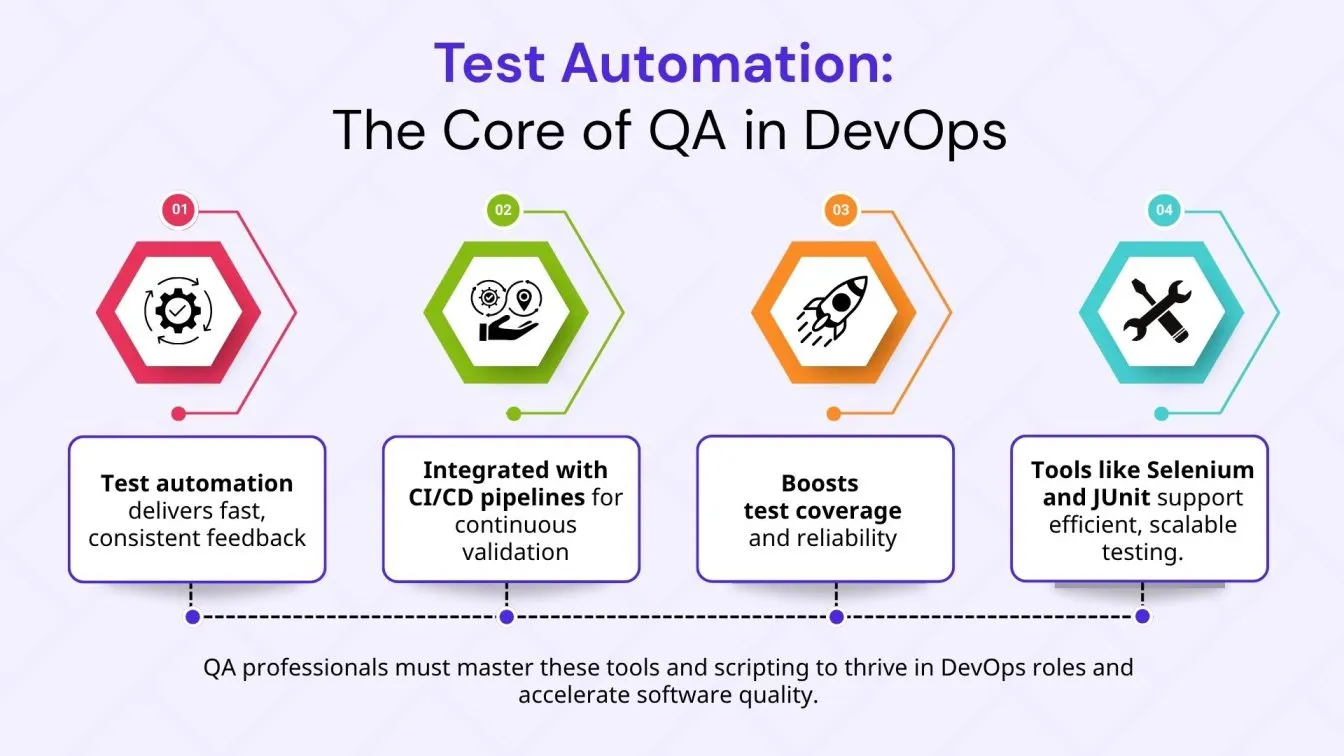
Collaboration Between Developers and QA in DevOps Culture
In a successful DevOps culture, collaboration between developers and QA is not optional it’s a core principle. DevOps breaks down silos, encouraging developers and QA engineers to work side-by-side from planning through deployment. This synergy results in faster feedback, higher-quality software, and fewer bugs in production.
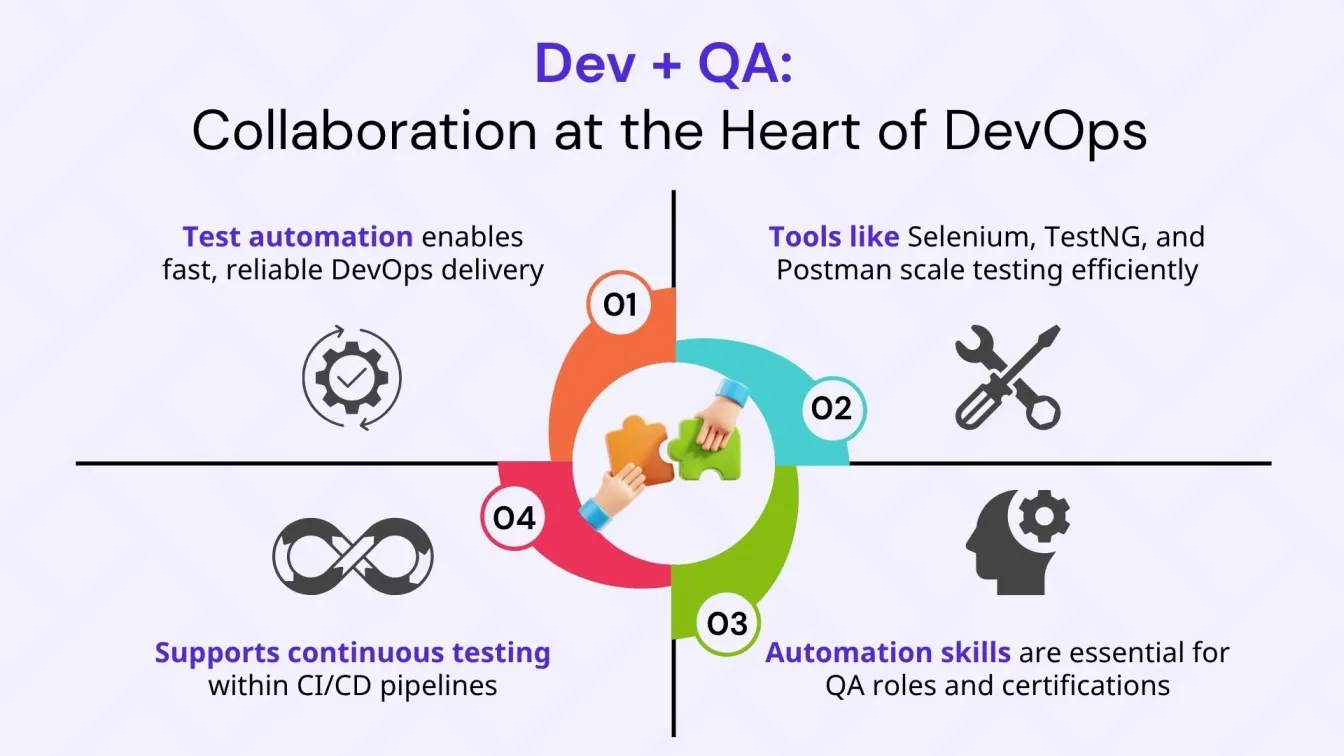
QA teams now help shape software, not just verify it. Developers write unit tests, while QA engineers build automation scripts for CI pipelines using tools like Azure DevOps, GitLab, and AWS DevOps-sharing pipelines, logs, and test reports for seamless collaboration.
This collaborative mindset supports the shift-left approach in DevOps, involving QA early in sprints, code reviews, and stand-ups to prevent miscommunication and late-stage issues.
Embracing Shift-Left Testing: Fix Issues Before They Escalate
Shift-left testing in DevOps moves QA to the start of development, allowing early defect detection, less rework, and faster delivery. It integrates testing from the moment code is written.
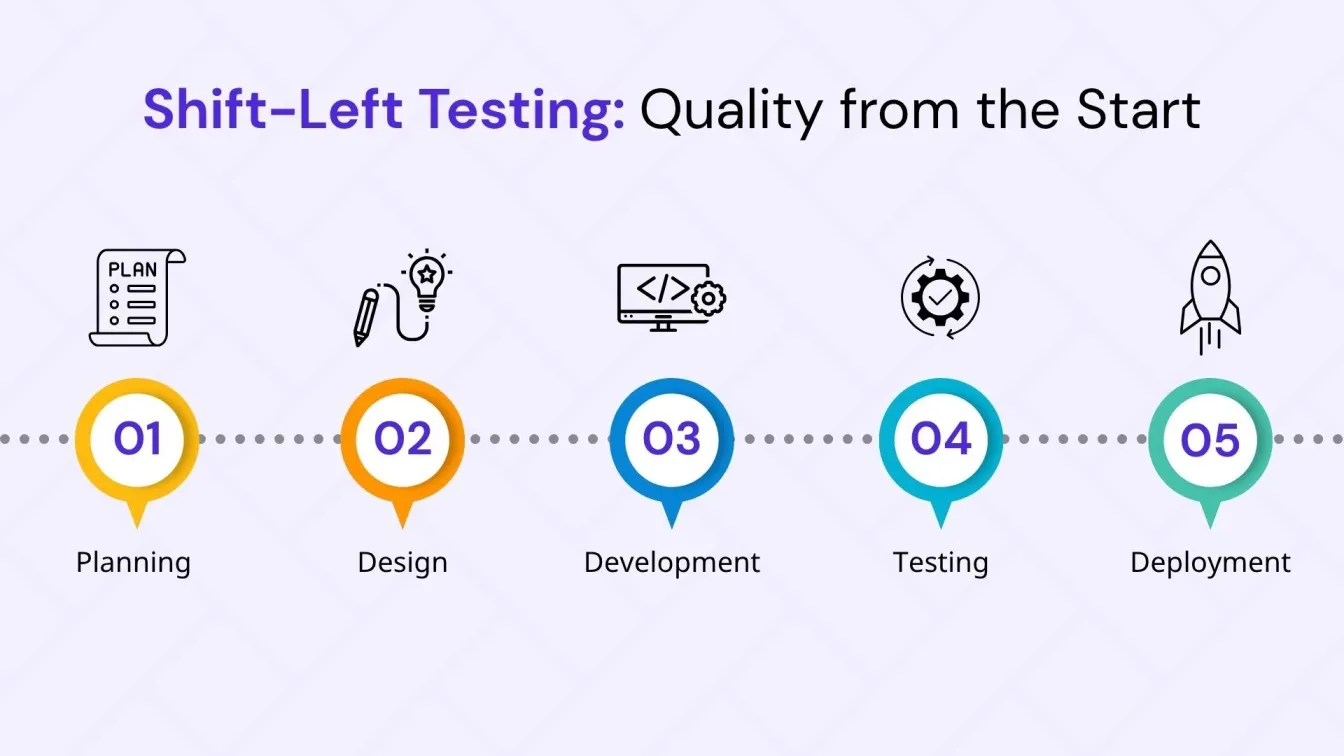
Key Benefits and Practices of Shift-Left Testing:
- Early Test Creation:
Unit and integration tests are written in parallel with feature development, ensuring that every code change is validated from the start. - Automation Framework Integration:
Tools like JUnit, RestAssured, and Selenium are essential in implementing shift-left strategies. These are integrated into CI pipelines using platforms like Azure DevOps and AWS DevOps. - Shortened Feedback Loops:
Continuous integration triggers automated tests, providing real-time feedback that helps teams resolve issues before they become critical. - Improved Test Coverage:
Testing early and often results in more comprehensive coverage, reducing the risk of undetected bugs in production. - Better Collaboration:
Shift-left testing promotes collaboration between developers, QA testers, and product owners-aligning quality goals with business requirements and agile practices. - Supports Core DevOps Principles:
It enables continuous testing, faster releases, and ensures consistent quality, which are fundamental to DevOps success.
Embracing shift-left testing is not just a trend-it’s a DevOps best practice necessary for building resilient, high-quality applications in today’s fast-paced, agile-driven development environments.
Why Manual Testing Alone Isn’t Enough Anymore
Manual testing aids in UI and exploratory checks, but automation is crucial in DevOps for fast, repeatable testing and continuous delivery.
Automated tests can be executed in seconds across multiple environments, ensuring consistent results. QA engineers who only focus on manual testing may struggle to contribute effectively in DevOps teams. That’s why DevOps certification programs and QA training now emphasize automation skills using tools like Selenium, TestNG, Postman, and Cucumber.
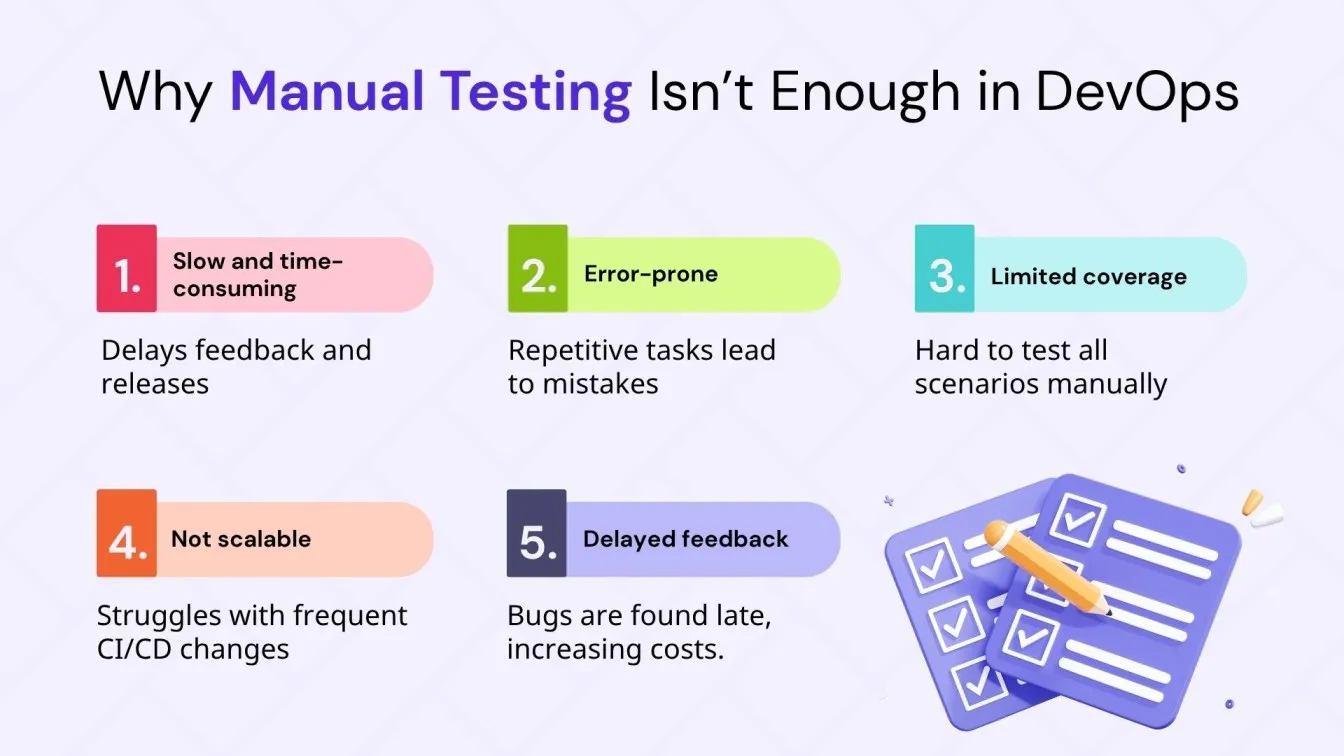
While manual testing is still necessary for human-centric validation, it must be supplemented with automation to meet modern demands. In the DevOps model, quality is everyone’s responsibility-and automation is the tool that makes continuous delivery and rapid feedback possible.
Popular Frameworks for DevOps Test Automation
Test automation in DevOps thrives on using the right frameworks-tools like Selenium, JUnit, TestNG, RestAssured, and Cucumber offer flexibility, strong community support, and CI/CD integration.
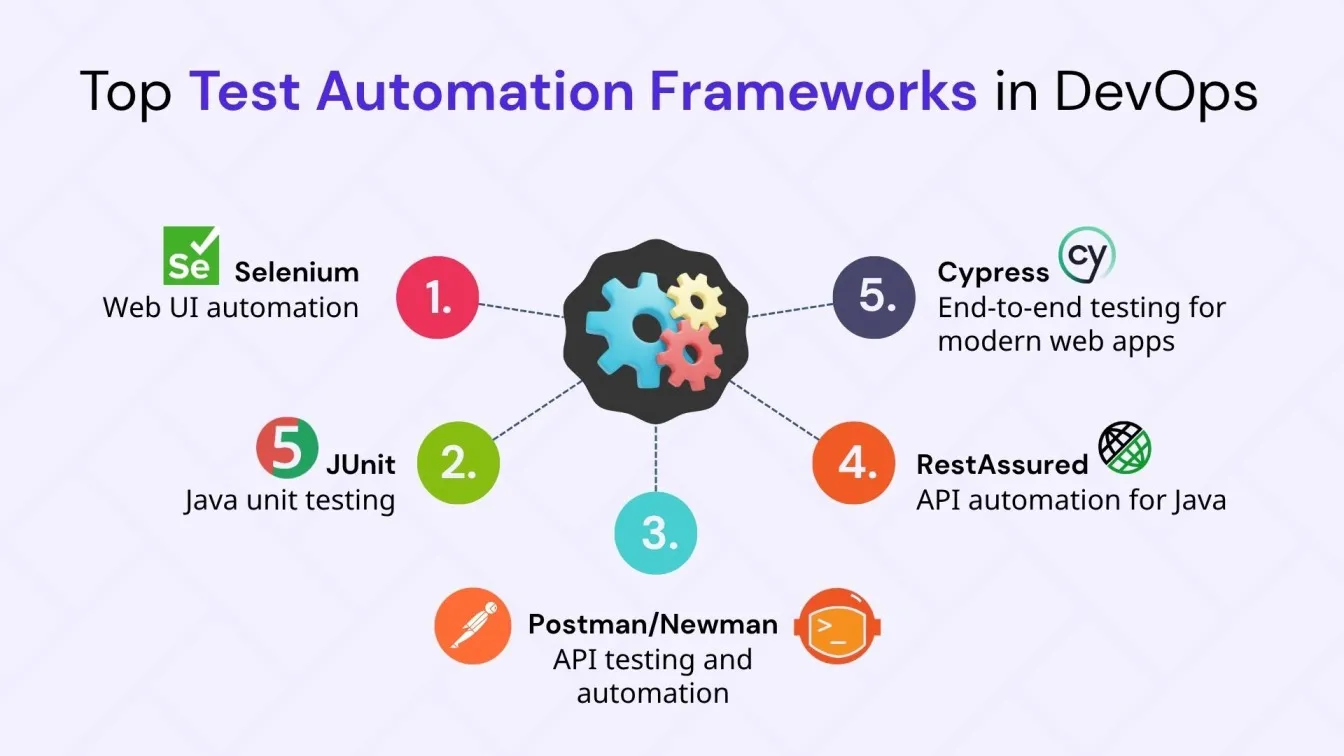
Selenium is the go-to framework for web UI testing, supporting multiple browsers and languages. JUnit and TestNG are used for unit and integration testing in Java-based applications. Cucumber enables behavior-driven development (BDD), fostering collaboration between developers and QA by writing tests in plain English.
RestAssured is a robust API testing tool for automating functional and performance tests in DevOps pipelines, integrating well with platforms like Azure DevOps and Jenkins. QA professionals should master it through hands-on training and certifications to boost their careers..
Understanding which framework fits your project needs and how to implement it in CI/CD pipelines is critical to continuous testing and overall DevOps success.
Real-Time Monitoring and Feedback Loops: Improving QA Visibility
In DevOps, real-time monitoring and feedback are key to ensuring quality after deployment. Unlike traditional QA, it focuses on continuous observation for quicker issue resolution and long-term stability..
QA teams now collaborate with DevOps engineers to monitor app health using tools like Prometheus, Grafana, Azure Monitor, and AWS CloudWatch. These tools offer insights into performance, errors, and user behavior, with real-time alerts sent via Slack or Teams to keep everyone informed..
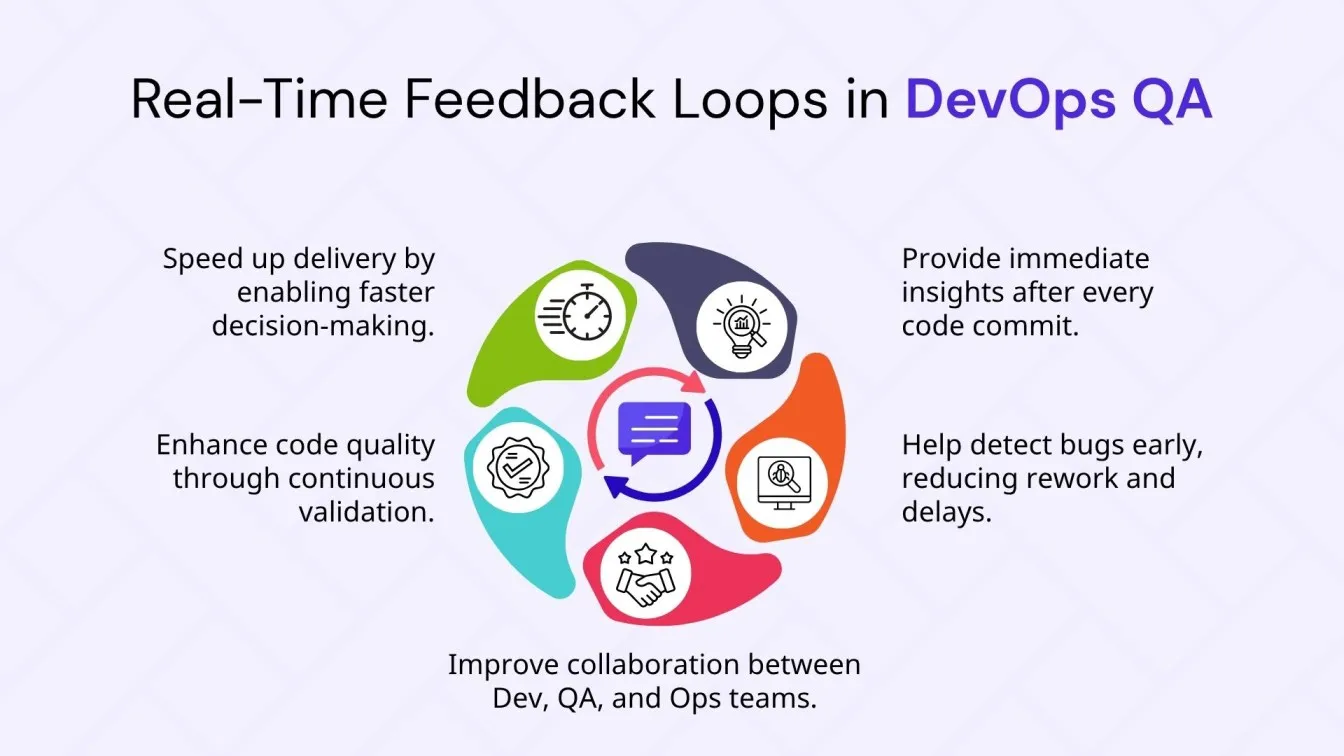
This visibility allows QA to shift-right monitoring quality in production environments and gathering data for test enhancement. It also helps close the feedback loop, where user issues and system anomalies guide new test scenarios.
DevOps tutorials and certifications now highlight observability, stressing telemetry, logging, and monitoring in QA. QA professionals must learn to read metrics and logs, aligning with developers and operations as part of the full DevOps roadmap.
By actively participating in feedback loops, QA engineers ensure continuous improvement, accountability, and high-quality user experiences-hallmarks of mature DevOps environments.
Top DevOps Tools Empowering QA Teams
QA in DevOps relies on powerful tools that enable automation, collaboration, and continuous validation across integration, testing, deployment, and monitoring..
Some of the most popular DevOps tools include:
- Azure DevOps: A comprehensive platform offering boards, repos, pipelines, and test plans.
- Jenkins: An open-source CI/CD tool that integrates with virtually any testing framework.
- GitLab CI/CD: Combines version control with integrated DevOps pipelines.
- Selenium: Widely used for web UI test automation.
- Postman: Ideal for API testing and automation.
- RestAssured: A robust library for automating RESTful web service testing.
- SonarQube: Helps maintain code quality and security by analyzing test coverage and vulnerabilities.
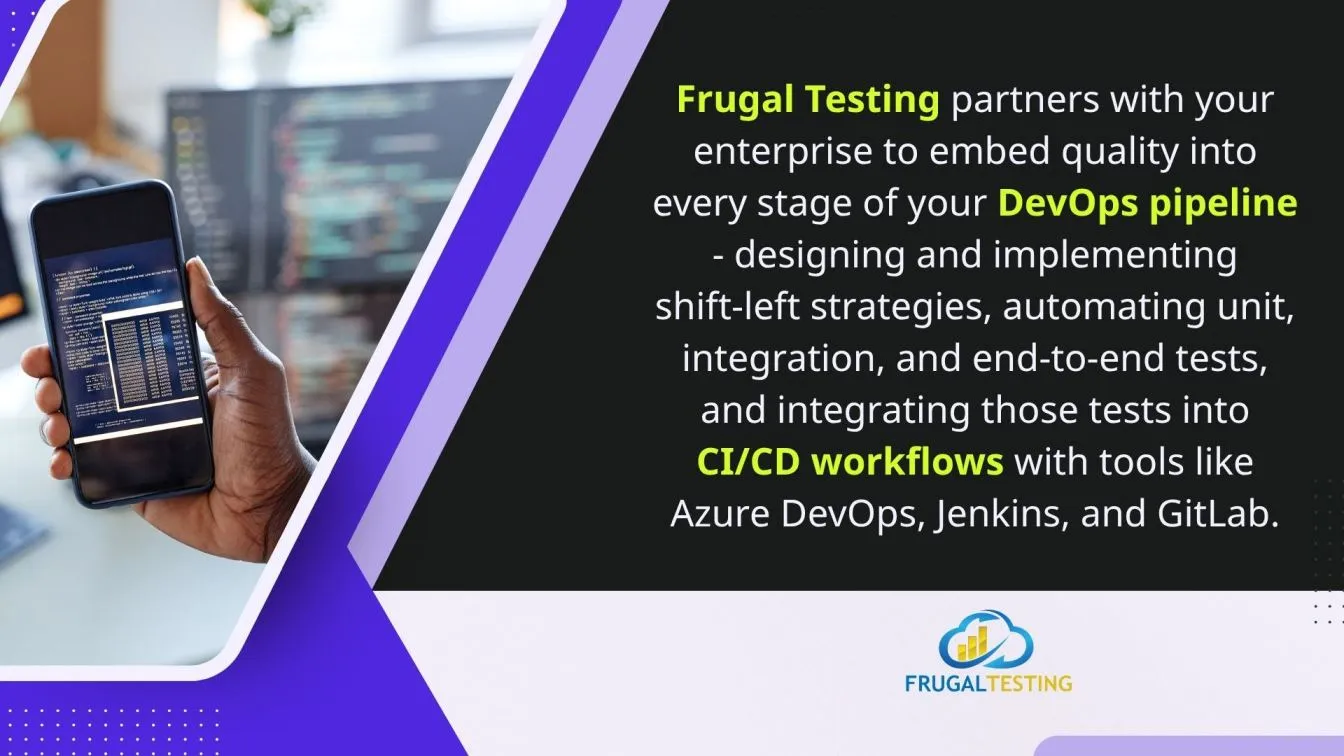
QA professionals should take hands-on DevOps training and pursue certifications like Azure or AWS DevOps. Choosing the right tools based on team goals and tech stack helps QA align with development and operations, boosting efficiency and product quality.
Conclusion: What’s Next? Future-Proofing QA in DevOps
As DevOps continues to redefine modern software development, QA is no longer a standalone phase it’s a continuous, collaborative practice embedded across the entire SDLC. From shift-left testing and CI/CD integration to real-time monitoring and test automation, QA professionals are evolving into proactive contributors who drive speed, stability, and quality at scale.
Mastering DevOps tools, frameworks, and certifications is now essential for QA teams to stay relevant and impactful. With automation at the core and collaboration as the foundation, DevOps empowers QA to deliver smarter, faster, and more reliable software-making it an indispensable pillar in enterprise software delivery.
By embracing this transformation, QA teams not only keep pace with innovation but also lead the charge in building future-ready, high-performance digital solutions.
Frequently Asked Questions (FAQs)
👉 How Does DevOps enhance the speed and reliability of software delivery.
DevOps accelerates software delivery by automating testing, streamlining CI/CD pipelines, and enabling real-time collaboration between developers and QA using tools like Azure DevOps
👉 What is the benefit of implementing Agile and DevOps in Software Quality assurances.
Combining Agile and DevOps enhances quality assurance through early testing, faster feedback, automation, and improved collaboration across teams for continuous, reliable software delivery.
👉 What is DevOps and Explain its significance in modern software development practices?
DevOps improves SDLC by automating each stage, ensuring faster releases, early bug detection, and continuous integration with QA using tools like Selenium and Postman.
👉 How does DevOps influence software architecture?
DevOps promotes modular architecture, microservices, automation readiness, and observability-enabling scalable, testable systems aligned with agile testing and automation frameworks like Python and Selenium.
👉 What is the QA Environment in DevOps.
The QA environment in DevOps integrates automation tools, test case management, and CI/CD pipelines for continuous, scalable, and reliable software testing throughout the development cycle.
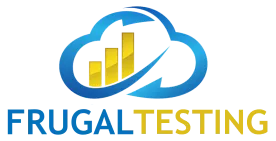


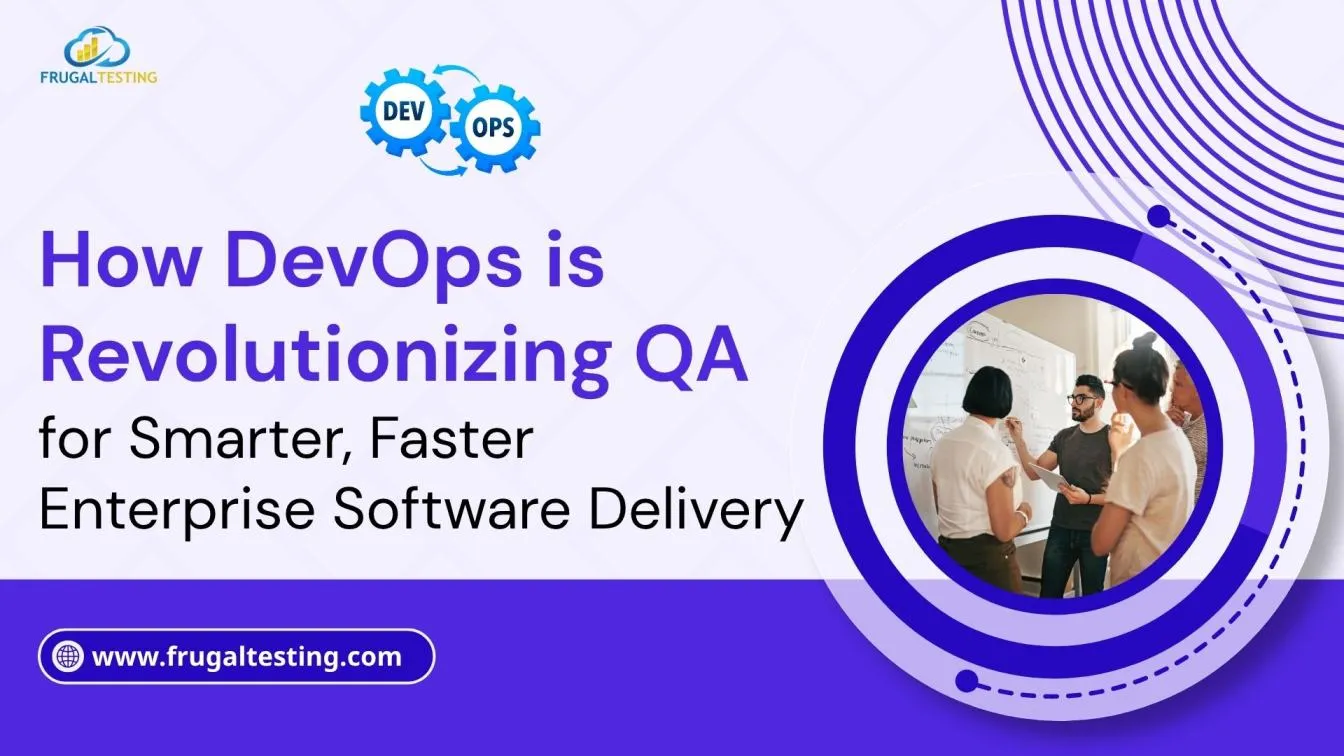

%201.webp)

